A Coupled CFD-DEM Study on the Effect of Basset Force Aimed at the Motion of a Single Bubble
Abstract
:1. Introduction
2. Methodology
2.1. Discrete Phase
2.2. Continuous Phase
2.3. Bubble–Fluids Interactions
3. Validation Tests
3.1. Experimental
3.2. Simulation Conditions
3.3. Results
4. Discussion
4.1. Initial Velocity Effects
4.2. Releasing Depth Effects
4.3. Bubble Size Effects
4.4. Two-Phase Density Ratio Effects
4.5. Two-Phase Viscosity Ratio Effects
5. Conclusions
- (a)
- Basset force represents the influence of unsteady viscosity in the process of motion; hence, it should not be ignored. In particular, by the method of Fourier series representation, Basset force on the particles/bubbles is very small and can be ignored for the high-frequency component in the turbulent flow field.
- (b)
- In order to realize the unsteady coupling process of the bubble, a coupled CFD-DEM model with Basset force is constructed, and there is good agreement with the experimental and numerical results.
- (c)
- Five potential influence factors are studied in this work: initial velocity, releasing depth, bubble size, density ratio and viscosity ratio. In our cases, /(+) and |/| are employed to quantify the contribution of Basset force, and the results indicated that:
- (1)
- Basset force is a matter of less significance to the bubble with higher initial velocity due to a larger order of magnitude of drag force than Basset force, and the effect of Basset force can be ignored in the case of ≥ 20 m/s.
- (2)
- It is evident that the shallower the releasing depth is, the smaller the pressure at the initial position is, resulting in the lower impact of Basset force on the bubble motion. Or more quantitatively, when the releasing depth is smaller than 6.9 m, its effect can be negligible.
- (3)
- As for the bubble size, the effect of Basset force on the bubble motion decreases with the diameter increasing, and the Basset force is considered to be overlooked when the bubble diameter is larger than 1 mm.
- (4)
- When the density ratio becomes smaller, there is a more intensified effect of Basset force on the bubble motion due to the low inertia of the bubble. Moreover, the calculation of Basset force can be ignored when the density ratio is greater than 1.14 × 10−3.
- (5)
- In terms of the smaller viscosity ratio, the effect of Basset force on the bubble motion becomes more delayed, because the greater fluid viscosity leads to a larger shear force per unit velocity and worse momentum exchange. When the viscosity ratio is smaller than 0.028, the contribution of Basset force reduces to 0.1, and it is regarded to be negligible.
Supplementary Materials
Author Contributions
Funding
Institutional Review Board Statement
Informed Consent Statement
Data Availability Statement
Acknowledgments
Conflicts of Interest
Nomenclature
| correction coefficient | |
| drag coefficient | |
| d | diameter, m |
| Basset force, N | |
| drag force, N | |
| contact force, N | |
| noncontact force, N | |
| Bubble–fluid interaction force, N | |
| gravity force, N | |
| reacting force of bubble–fluid interactions, N | |
| h | releasing depth, m |
| moment of inertia | |
| identity matrix | |
| rolling friction moments, N·m | |
| tangential friction moments, N·m | |
| m | mass, kg |
| P | pressure, Pa |
| Q | flow rate, L/h |
| Re | Reynolds number |
| time, s | |
| initial time, s | |
| time to reach liquid surface, s | |
| the time differences between the simulation and the experiment, s | |
| fluid velocity, m/s | |
| volume, m3 | |
| bubble/particle velocity, m/s | |
| bubble velocity in the case with Basset force, m/s | |
| translation velocity of the bubble, m/s | |
| rising velocity, m/s | |
| the velocity differences between the simulation and the experiment, m/s | |
| Greek symbols | |
| volume fraction, | |
| density, kg/m3 | |
| dynamic viscosity, Pa·s | |
| angular velocity of the bubble, rad/s | |
| shear viscosity of phase-q, Pa·s | |
| bulk viscosity of phase-q, Pa·s | |
| Subscripts | |
| b | bubble phase |
| f | fluid phase |
| q | phase-q |
References
- Atamanchuk, D.; Koelling, J.; Send, U.; Wallace, D.W.R. Rapid transfer of oxygen to the deep ocean mediated by bubbles. Nat. Geosci. 2020, 13, 232–237. [Google Scholar] [CrossRef]
- Bhamitipadi Suresh, D.; Aju, E.J.; Pham, D.T.; Jin, Y. On the incipient sediment suspension downstream of three-dimensional wall-mounted obstacles. Phys. Fluids 2021, 33, 083307. [Google Scholar] [CrossRef]
- Zhao, W.; Cheng, Y.; Guo, P.; Jin, K.; Tu, Q.; Wang, H. An analysis of the gas-solid plug flow formation: New insights into the coal failure process during coal and gas outbursts. Powder Technol. 2017, 305, 39–47. [Google Scholar] [CrossRef]
- Saleh, S.N.; Barghi, S. Reduction of fine particle emission from a prilling tower using CFD simulation. Chem. Eng. Res. Des. 2016, 109, 171–179. [Google Scholar] [CrossRef]
- Wu, Y.; Jiang, Z.; Lin, Z.; Liang, Y.; Wang, H. Direct electrosynthesis of methylamine from carbon dioxide and nitrate. Nat. Sustain. 2021, 4, 725–730. [Google Scholar] [CrossRef]
- Zhao, K.; Shen, Y.-Z.; Kong, Z.; Zhang, Q.-R.; Zhang, Y.-Z.; Shi, Y.; Zhen, C.-L.; Shi, X.-F.; Zhang, X.-H. Three-dimensional numerical simulation of flow and splash behavior in an oxygen coal combustion melting and separating furnace. J. Iron Steel Res. Int. 2021, 28, 965–977. [Google Scholar] [CrossRef]
- Basset, A.B. A Treatise on Hydrodynamics; Cambridge University Press: Cambridge, UK, 1888; Volume 2. [Google Scholar]
- Stokes, G.G. On the Composition and Resolution of Streams of Polarized Light from different Sources. In Mathematical and Physical Papers; Stokes, G.G., Ed.; Cambridge University Press: Cambridge, UK, 1851; Volume 3, pp. 233–258. [Google Scholar]
- Basset, A.B.; Strutt, J.W., III. On the motion of a sphere in a viscous liquid. Proc. R. Soc. Lond. 1888, 179, 43–63. [Google Scholar] [CrossRef] [Green Version]
- Odar, F.; Hamilton, W.S. Forces on a sphere accelerating in a viscous fluid. J. Fluid Mech. 1964, 18, 302–314. [Google Scholar] [CrossRef] [Green Version]
- Daitche, A.; Tél, T. Memory Effects are Relevant for Chaotic Advection of Inertial Particles. Phys. Rev. Lett. 2011, 107, 244501. [Google Scholar] [CrossRef]
- Dodemand, E.; Prud’homme, R.; Kuentzmann, P. Influence of unsteady forces acting on a particle in a suspension application to the sound propagation. Int. J. Multiph. Flow 1995, 21, 27–51. [Google Scholar] [CrossRef]
- Boussinesq, M.J. Application des Potentiels à I’Étude de I’Éuilibre et du Mouvement des Solides Élastiques; Gauthier-Villars: Paris, France, 1885. [Google Scholar]
- Oseen, C.W. Neuere Methoden und Ergebnisse in der Hydrodynamik. Mon. Math. Phys. 1928, 35, A67–A68. [Google Scholar] [CrossRef]
- Clift, R.; Grace, J.R.; Weber, M.E. Bubbles, Drops and Particles; Academic Press: New York, NY, USA, 1978. [Google Scholar]
- Toschi, F.; Bodenschatz, E. Lagrangian Properties of Particles in Turbulence. Annu. Rev. Fluid Mech. 2009, 41, 375–404. [Google Scholar] [CrossRef]
- Elghobashi, S.; Truesdell, G.C. Direct simulation of particle dispersion in a decaying isotropic turbulence. J. Fluid Mech. 1992, 242, 655–700. [Google Scholar] [CrossRef]
- Armenio, V.; Fiorotto, V. The importance of the forces acting on particles in turbulent flows. Phys. Fluids 2001, 13, 2437–2440. [Google Scholar] [CrossRef]
- Olivieri, S.; Picano, F.; Sardina, G.; Iudicone, D.; Brandt, L. The effect of the Basset history force on particle clustering in homogeneous and isotropic turbulence. Phys. Fluids 2014, 26, 041704. [Google Scholar] [CrossRef] [Green Version]
- Lu, L.; Gao, X.; Li, T.; Benyahia, S. Numerical Investigation of the Ability of Salt Tracers to Represent the Residence Time Distribution of Fluidized Catalytic Cracking Particles. Ind. Eng. Chem. Res. 2017, 56, 13642–13653. [Google Scholar] [CrossRef]
- Lu, L.; Xu, Y.; Li, T.; Benyahia, S. Assessment of different coarse graining strategies to simulate polydisperse gas-solids flow. Chem. Eng. Sci. 2018, 179, 53–63. [Google Scholar] [CrossRef]
- Korevaar, M.W.; Padding, J.T.; Van der Hoef, M.A.; Kuipers, J.A.M. Integrated DEM–CFD modeling of the contact charging of pneumatically conveyed powders. Powder Technol. 2014, 258, 144–156. [Google Scholar] [CrossRef]
- Solnordal, C.B.; Wong, C.Y.; Boulanger, J. An experimental and numerical analysis of erosion caused by sand pneumatically conveyed through a standard pipe elbow. Wear 2015, 336–337, 43–57. [Google Scholar] [CrossRef]
- Chen, H.; Wei, S.; Ding, W.; Wei, H.; Li, L.; Saxén, H.; Long, H.; Yu, Y. Interfacial Area Transport Equation for Bubble Coalescence and Breakup: Developments and Comparisons. Entropy 2021, 23, 1106. [Google Scholar] [CrossRef]
- Takeda, H.; Esaki, N.; Doi, K.; Murakami, H.; Yamasaki, K.; Kawase, Y. Flow Simulation in Bubble Columns in Regard to Bubble Coalescence and Break-up Utilizing LES and DEM. J. Chem. Eng. Jpn. 2004, 37, 976–989. [Google Scholar] [CrossRef]
- Ge, L.; Evans, G.M.; Moreno-Atanasio, R. CFD-DEM investigation of the interaction between a particle swarm and a stationary bubble: Particle-bubble collision efficiency. Powder Technol. 2020, 366, 641–652. [Google Scholar] [CrossRef]
- Crapper, M.; Duursma, G.; Robertson, C.; Wong, S. EDEM-FLUENT investigation of bubble-tube interactions in gas-fluidized beds. In Proceedings of 7th International Conference on Multiphase Flow, Leipzig, Germany, 9–13 July 2007. [Google Scholar]
- Tsuji, Y.; Tanaka, T.; Ishida, T. Lagrangian numerical simulation of plug flow of cohesionless particles in a horizontal pipe. Powder Technol. 1992, 71, 239–250. [Google Scholar] [CrossRef]
- Mindlin, R. Compliance of Elastic Bodies in Contact. J. Appl. Mech. 1949, 16, 259–268. [Google Scholar] [CrossRef]
- Mindlin, R.; Deresiewicz, H. Elastic Spheres in Contact Under Varying Oblique Forces. J. Appl. Mech. 1953, 20, 327–344. [Google Scholar] [CrossRef]
- ANSYS. ANSYS FLUENT Theory Guide Inc., Release 15; ANSYS Academic Research: Canonsburg, PA, USA, 2013. [Google Scholar]
- Hjertager, B. Fundamentals of Computational Fluid Dynamics; Group for Chemical Fluid Flow Processes (CHEFF): Esbjerg, Denmark, 2009. [Google Scholar] [CrossRef]
- Ding, W.; Qi, B.; Chen, H.; Li, Y.; Xiong, Y.; Saxén, H.; Yu, Y. Numerical Simulation of Bubble and Velocity Distribution in a Furnace. Metals 2022, 12, 844. [Google Scholar] [CrossRef]
- Joel, H.F.; Peric, M. Computational Methods for Fluid Dynamics; Springer: Berlin/Heidelberg, Germany, 2002. [Google Scholar]
- Johnson, K.L. Contact Mechanics; Cambridge Univerisity Press: Cambridge, UK, 1985. [Google Scholar]
- Burns, S.J.; Piiroinen, P.T.; Hanley, K.J. Critical time step for DEM simulations of dynamic systems using a Hertzian contact model. Int. J. Numer. Methods Eng. 2019, 119, 432–451. [Google Scholar] [CrossRef] [Green Version]
- Tadaki, T.; Maeda, S. On the Shape and Velocity of Single Air Bubbles Rising in Various Liquids. Chem. Eng. 1961, 25, 254–264. [Google Scholar] [CrossRef] [Green Version]
- Wu, Q.; Ishii, M.; Uhle, J. Framework of two-group model for interfacial area transport in vertical two-phase flows. Trans. ANS 1998, 79, 351–352. [Google Scholar]
- Ishii, M.; Kim, S. Development of One-Group and Two-Group Interfacial Area Transport Equation. Nucl. Sci. Eng. 2004, 146, 257–273. [Google Scholar] [CrossRef]
- Wu, Q.; Kim, S.; Ishii, M.; Beus, S.G. One-group interfacial area transport in vertical bubbly flow. Int. J. Heat Mass Transf. 1998, 41, 1103–1112. [Google Scholar] [CrossRef]
- Ishii, M.; Zuber, N. Drag coefficient and relative velocity in bubbly, droplet or particulate flows. AIChE J. 1979, 25, 843–855. [Google Scholar] [CrossRef]
- Peng, Z.; Doroodchi, E.; Luo, C.; Moghtaderi, B. Influence of void fraction calculation on fidelity of CFD-DEM simulation of gas-solid bubbling fluidized beds. AIChE J. 2014, 60, 2000–2018. [Google Scholar] [CrossRef]
- Clarke, D.A.; Sederman, A.J.; Gladden, L.F.; Holland, D.J. Investigation of Void Fraction Schemes for Use with CFD-DEM Simulations of Fluidized Beds. Ind. Eng. Chem. Res. 2018, 57, 3002–3013. [Google Scholar] [CrossRef]
- Roache, P.J. Verification and Validation in Computational Science and Engineering; Hermosa: Albuqureque, NM, USA, 1998. [Google Scholar]
- Kwaśniewski, L. Application of grid convergence index in FE computation. Bull. Pol. Acad. Sci. Tech. Sci. 2013, 61, 123–128. [Google Scholar] [CrossRef] [Green Version]
- Chhabra, R.P. Bubbles, Drops, and Particles in Non-Newtonian Fluids; Taylor & Francis Group, LLC: Kanpur, India, 2007. [Google Scholar]
- Ferreira, J.M.; Chhabra, R.P. Accelerating motion of a vertically falling sphere in incompressible Newtonian media: An analytical solution. Powder Technol. 1998, 97, 6–15. [Google Scholar] [CrossRef]
- Ferreira, J.M.; Duarte Naia, M.; Chhabra, R.P. An analytical study of the transient motion of a dense rigid sphere in an incompressible Newtonian fluid. Chem. Eng. Commun. 1998, 168, 45–58. [Google Scholar] [CrossRef]

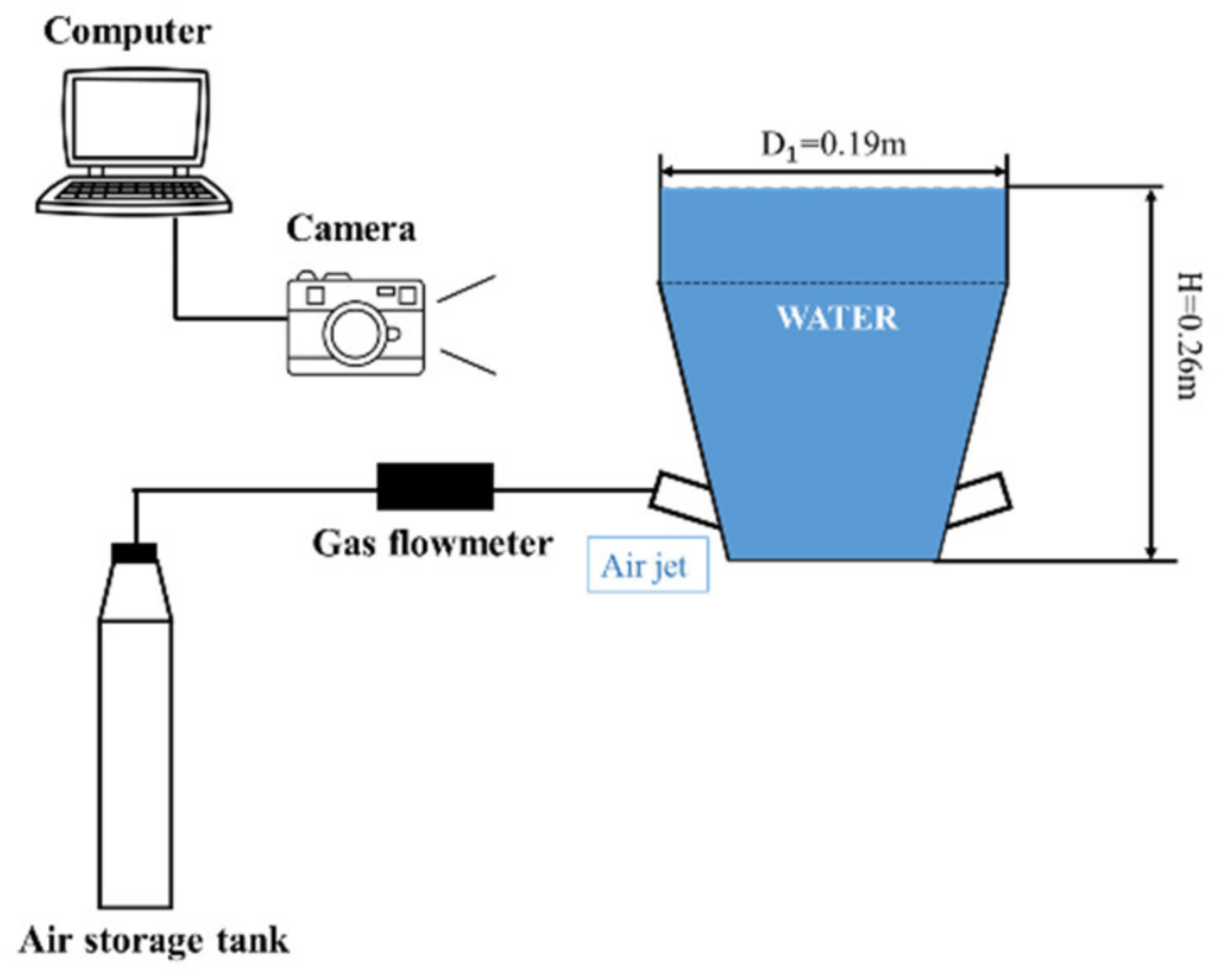
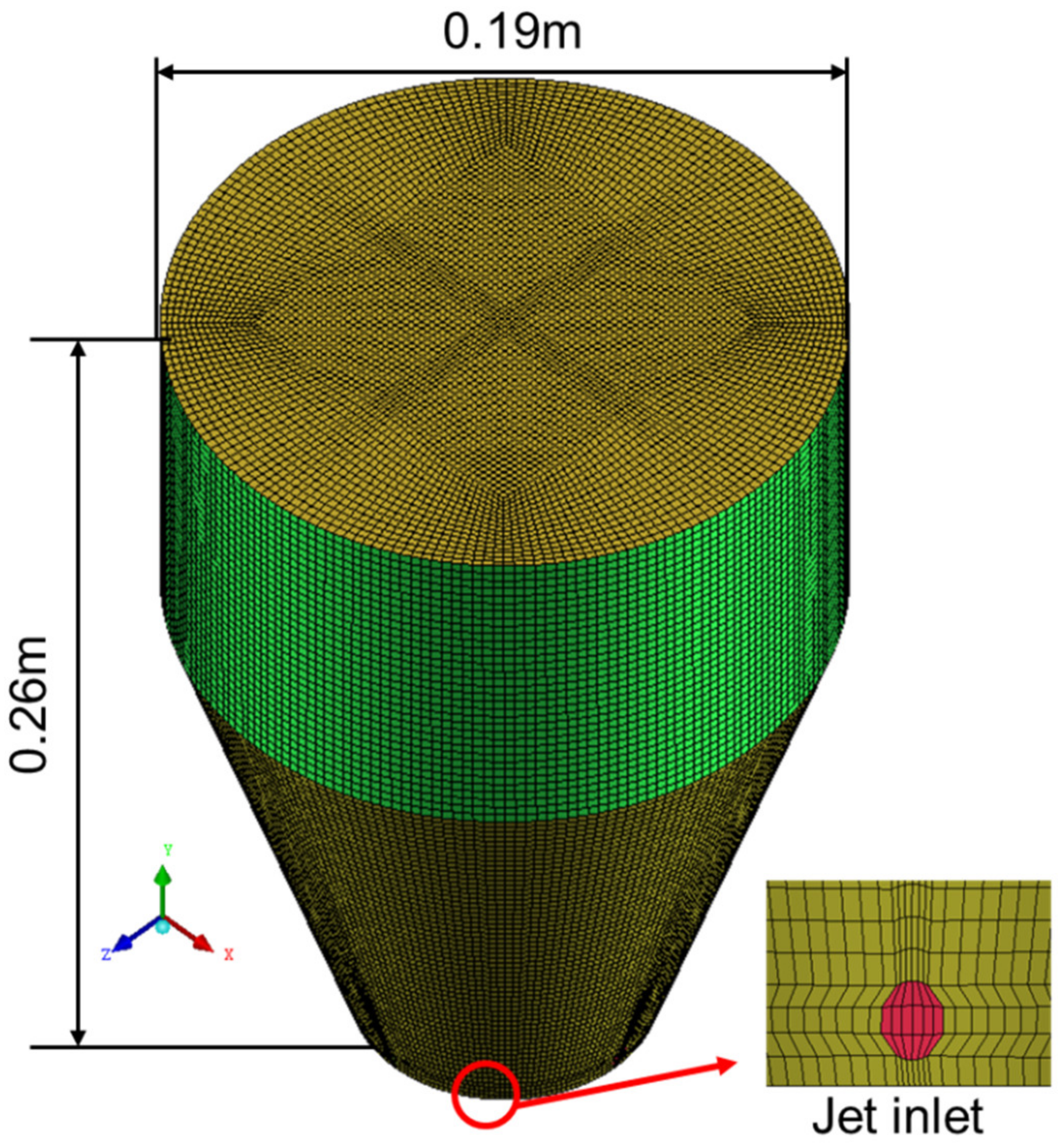

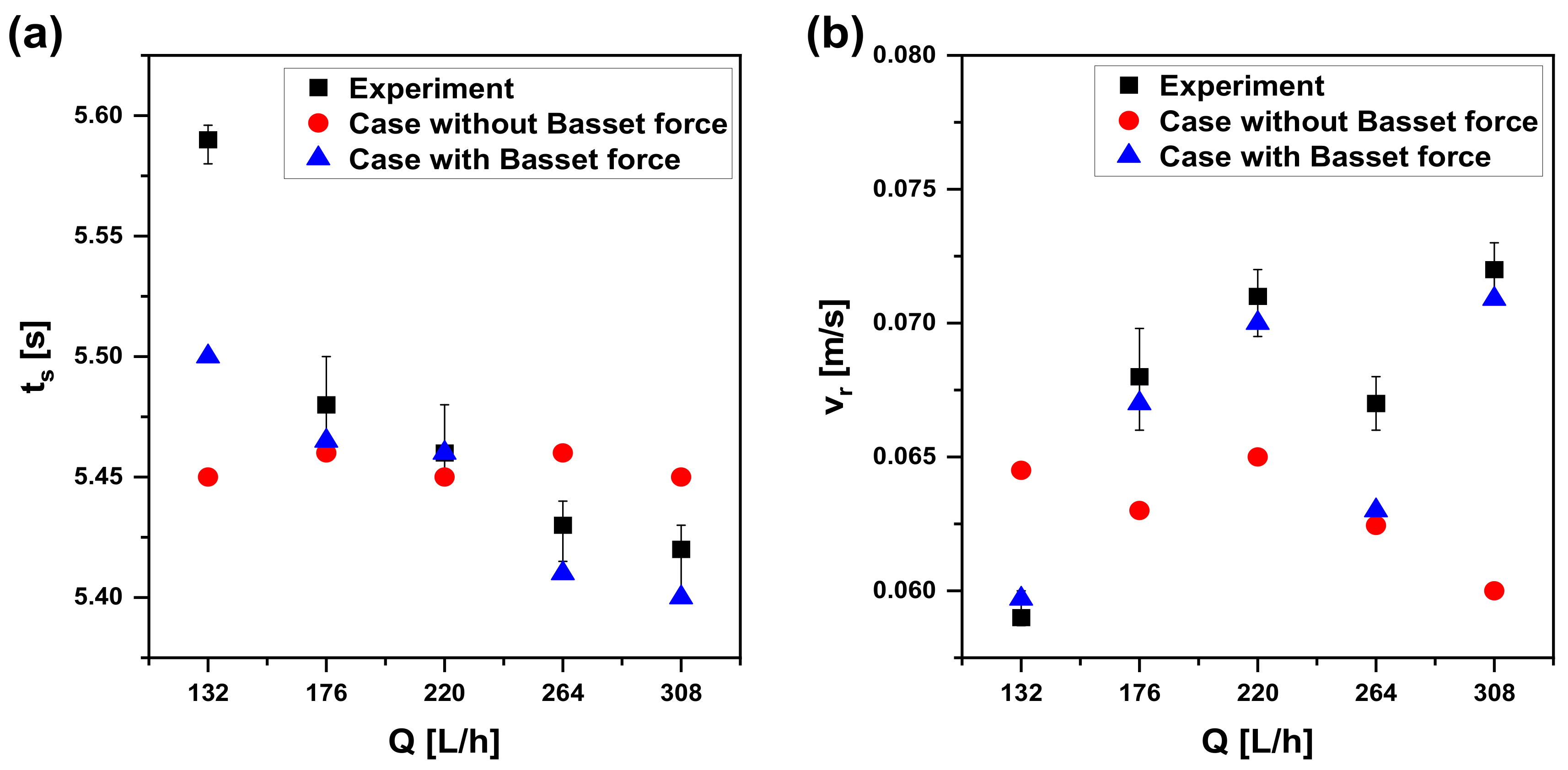
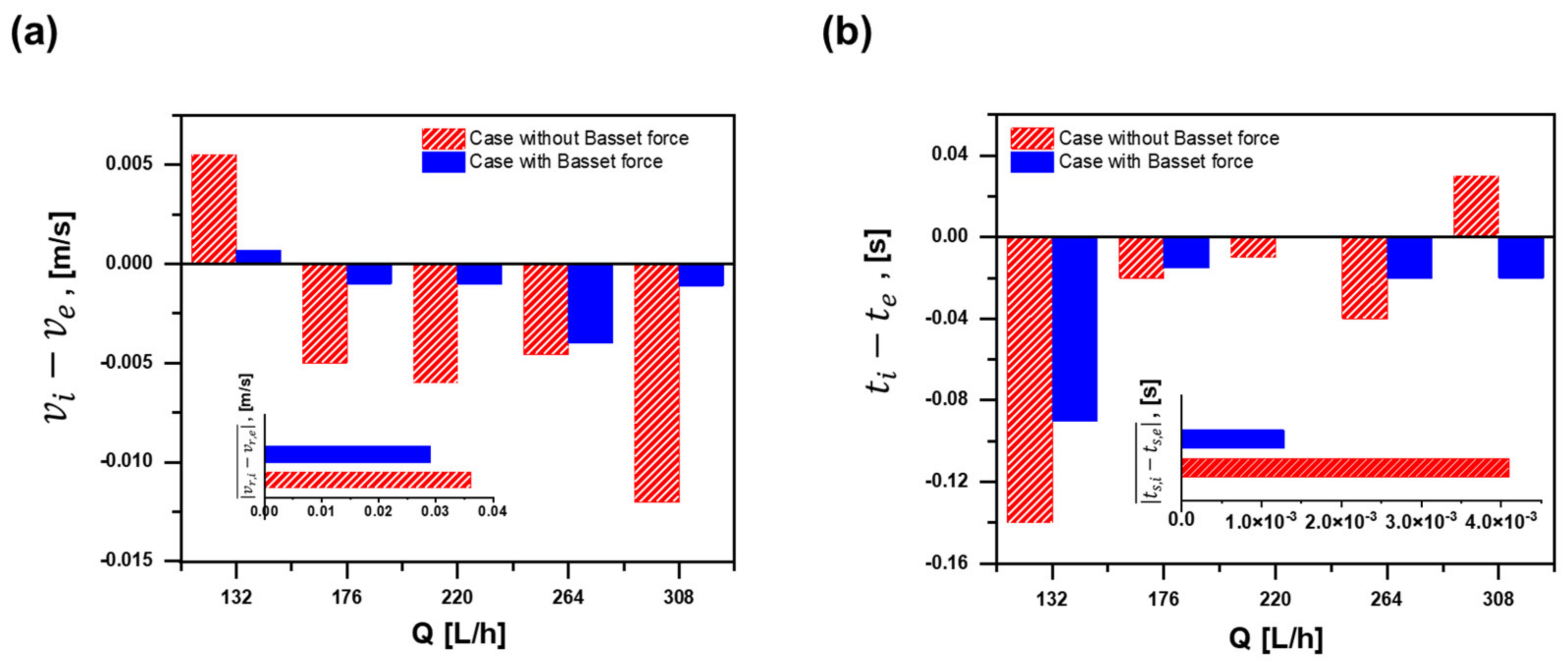
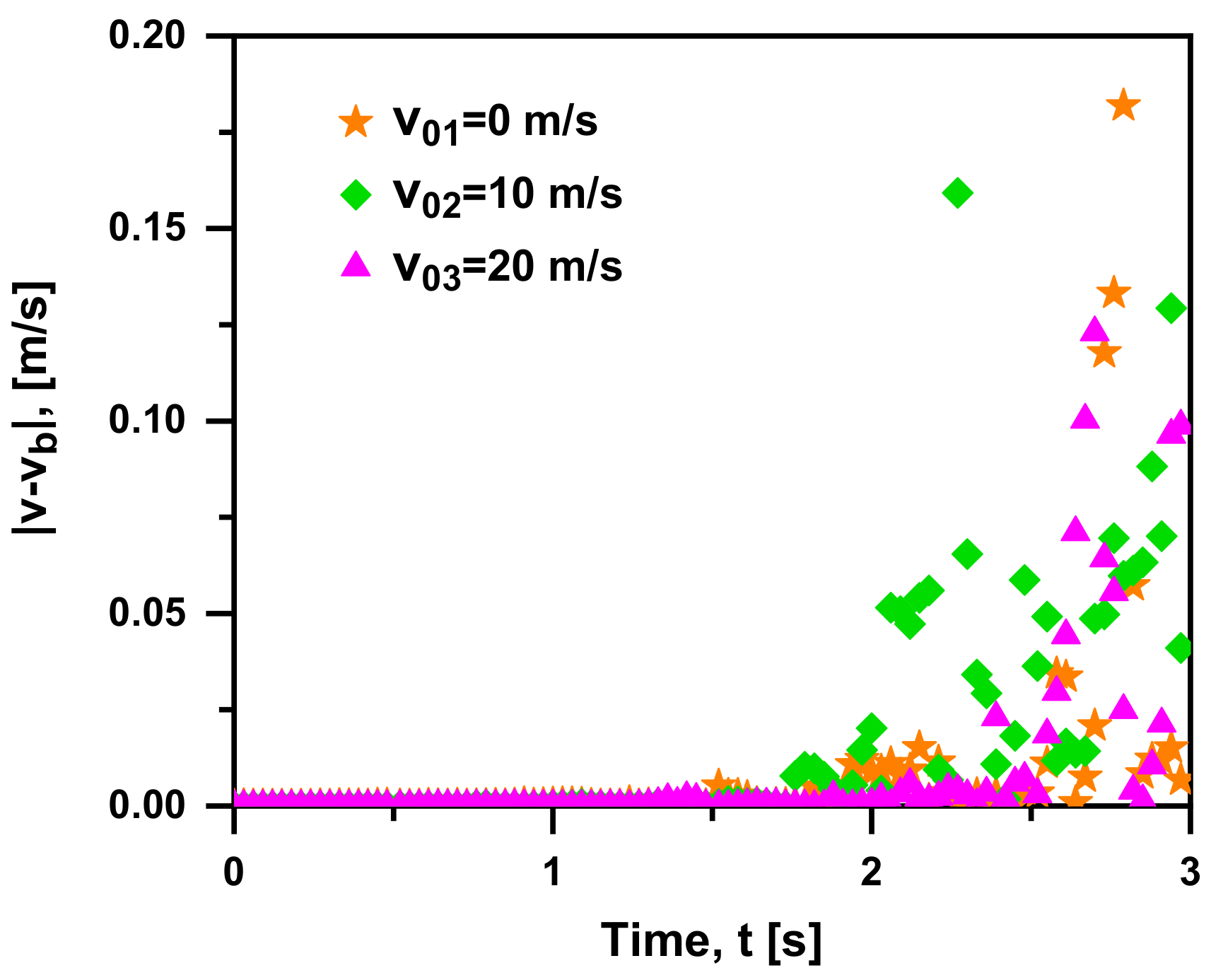
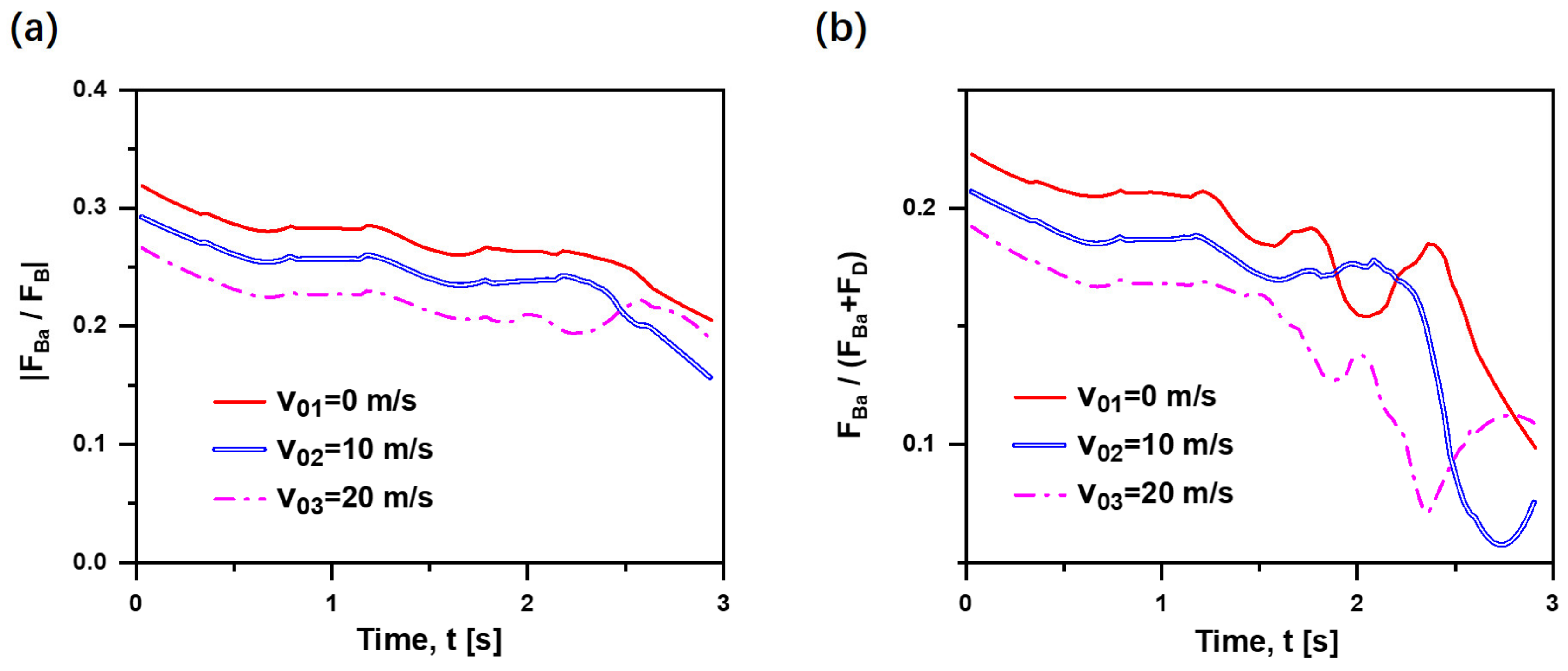
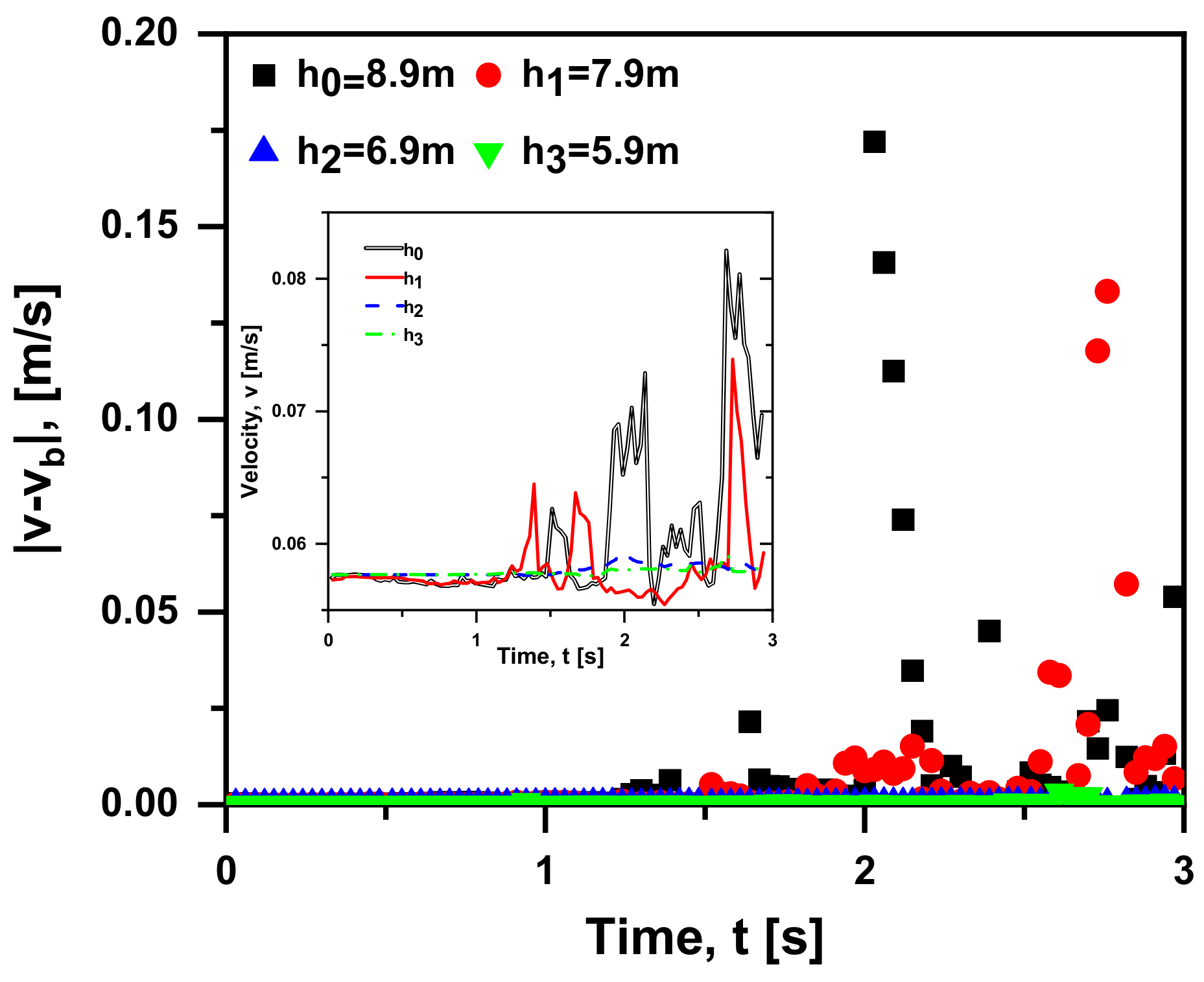
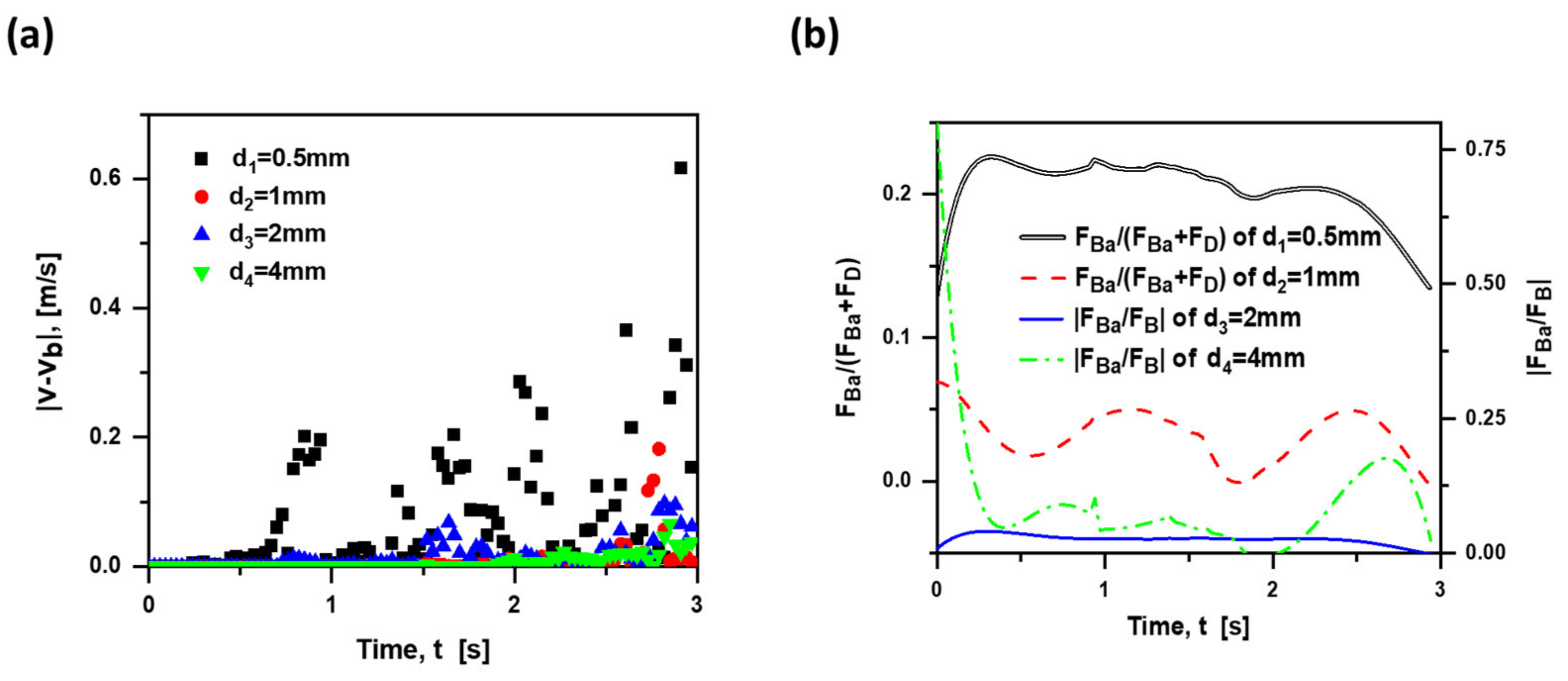
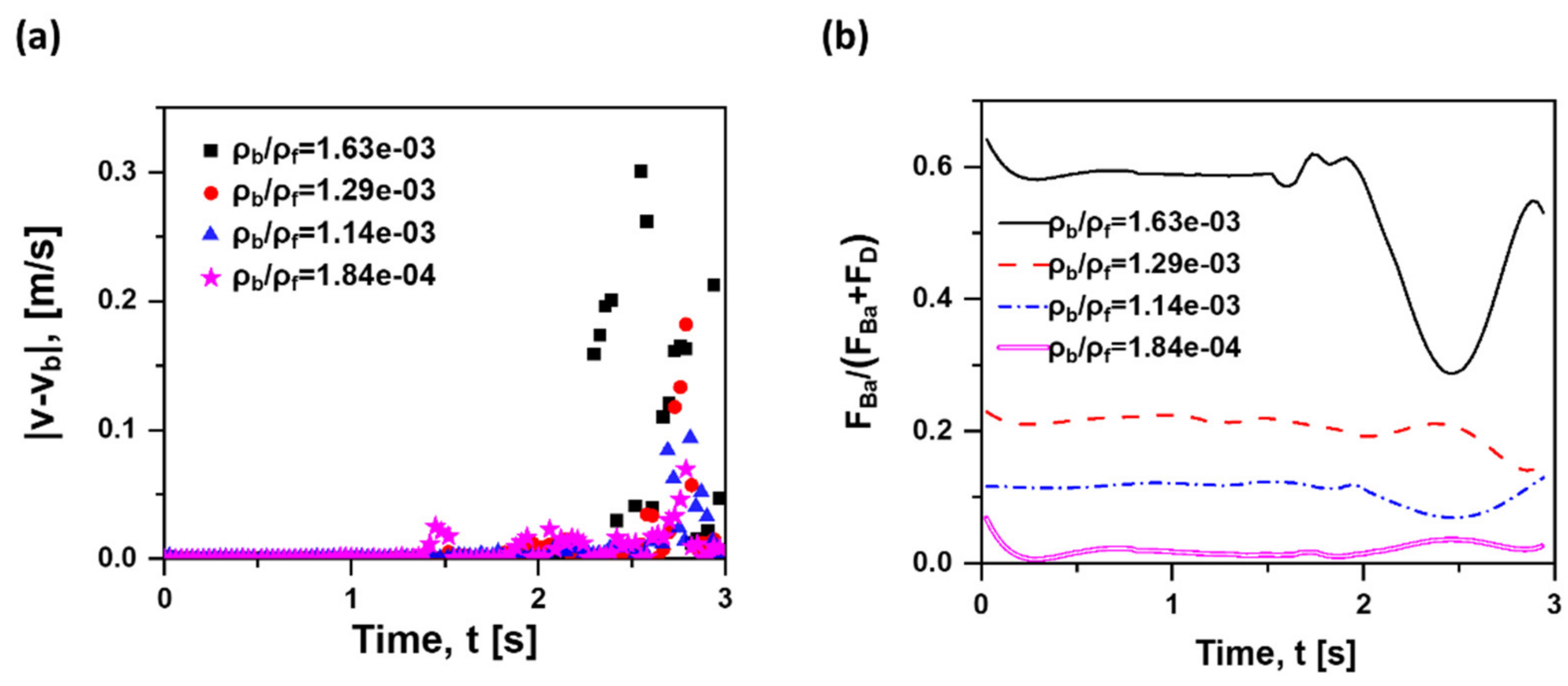
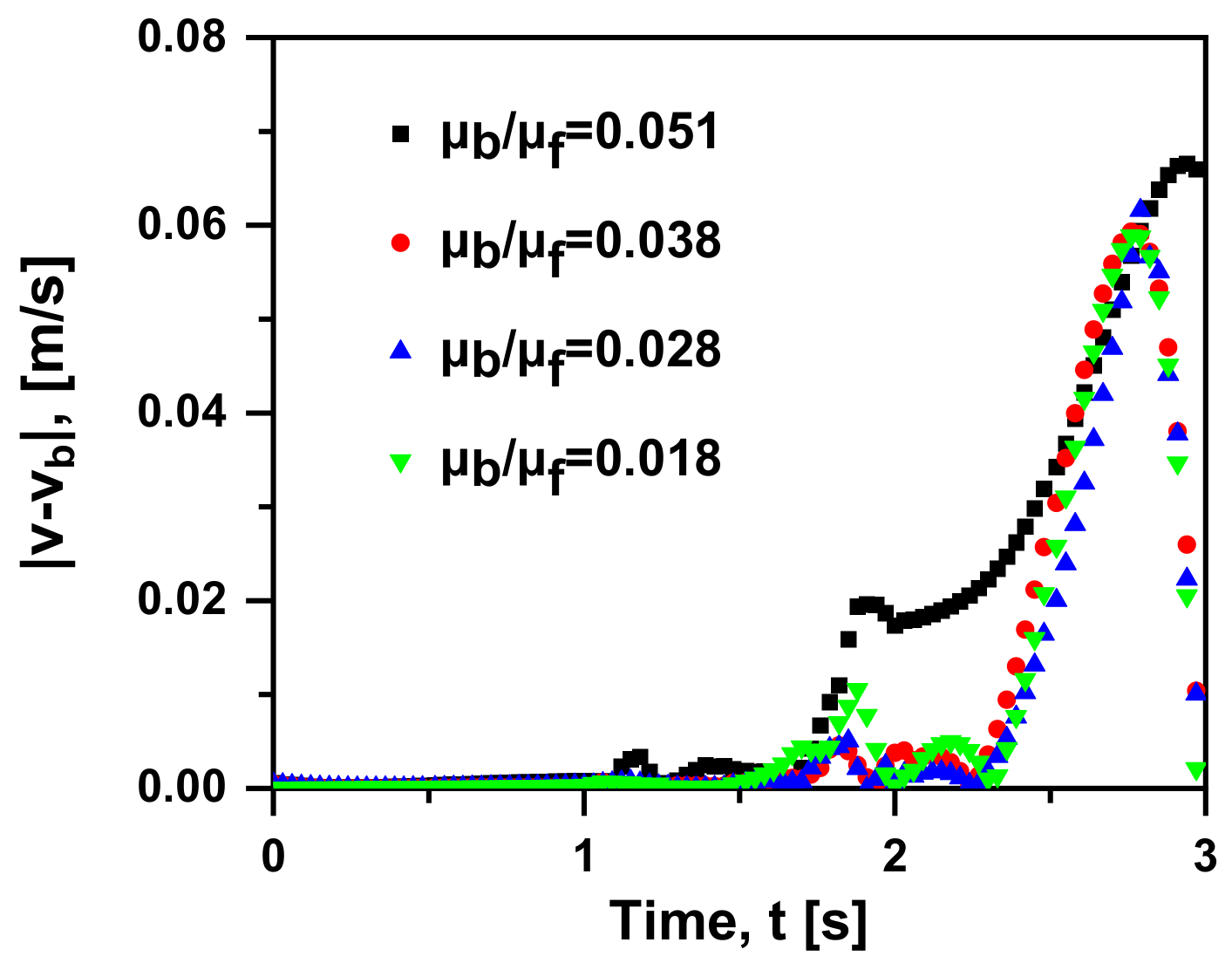
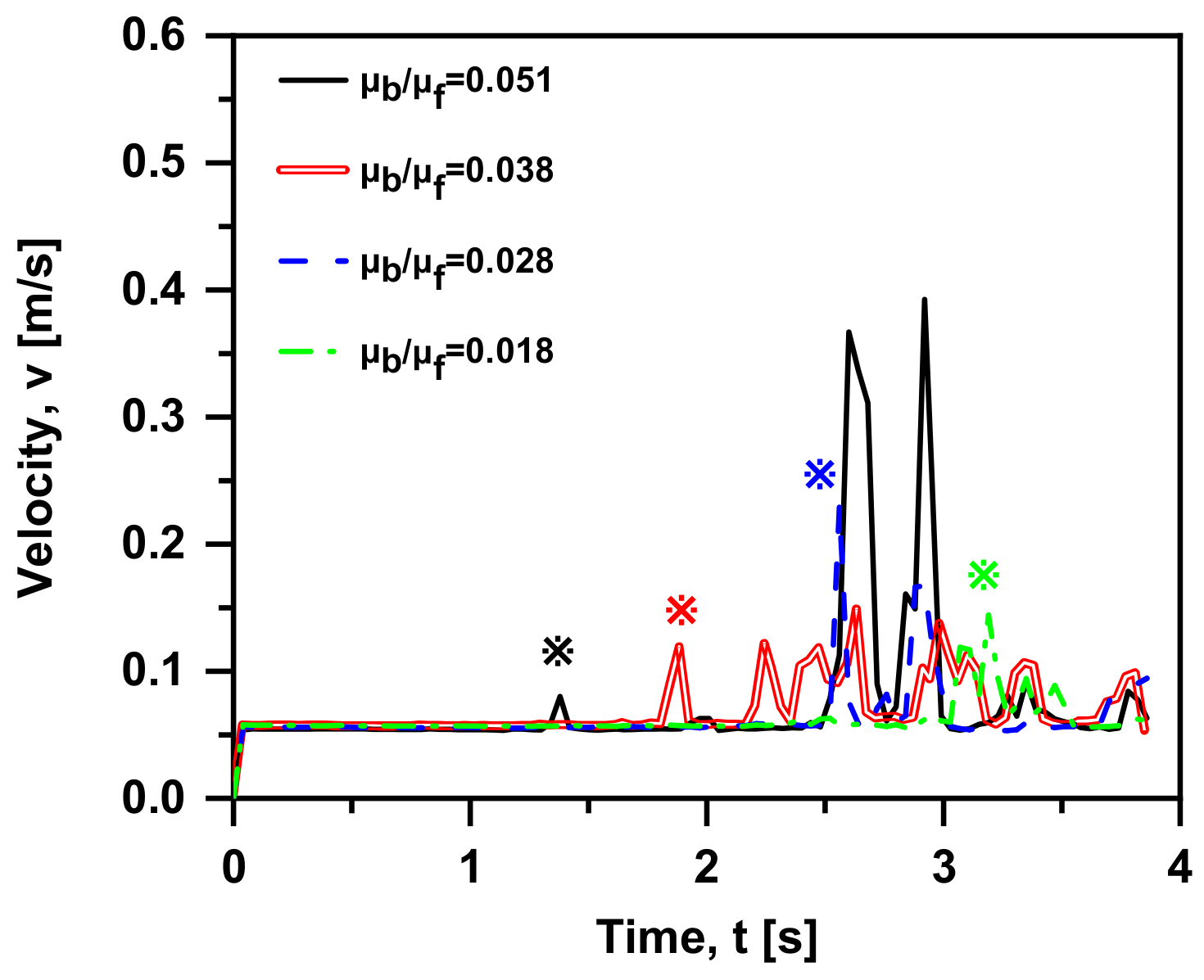
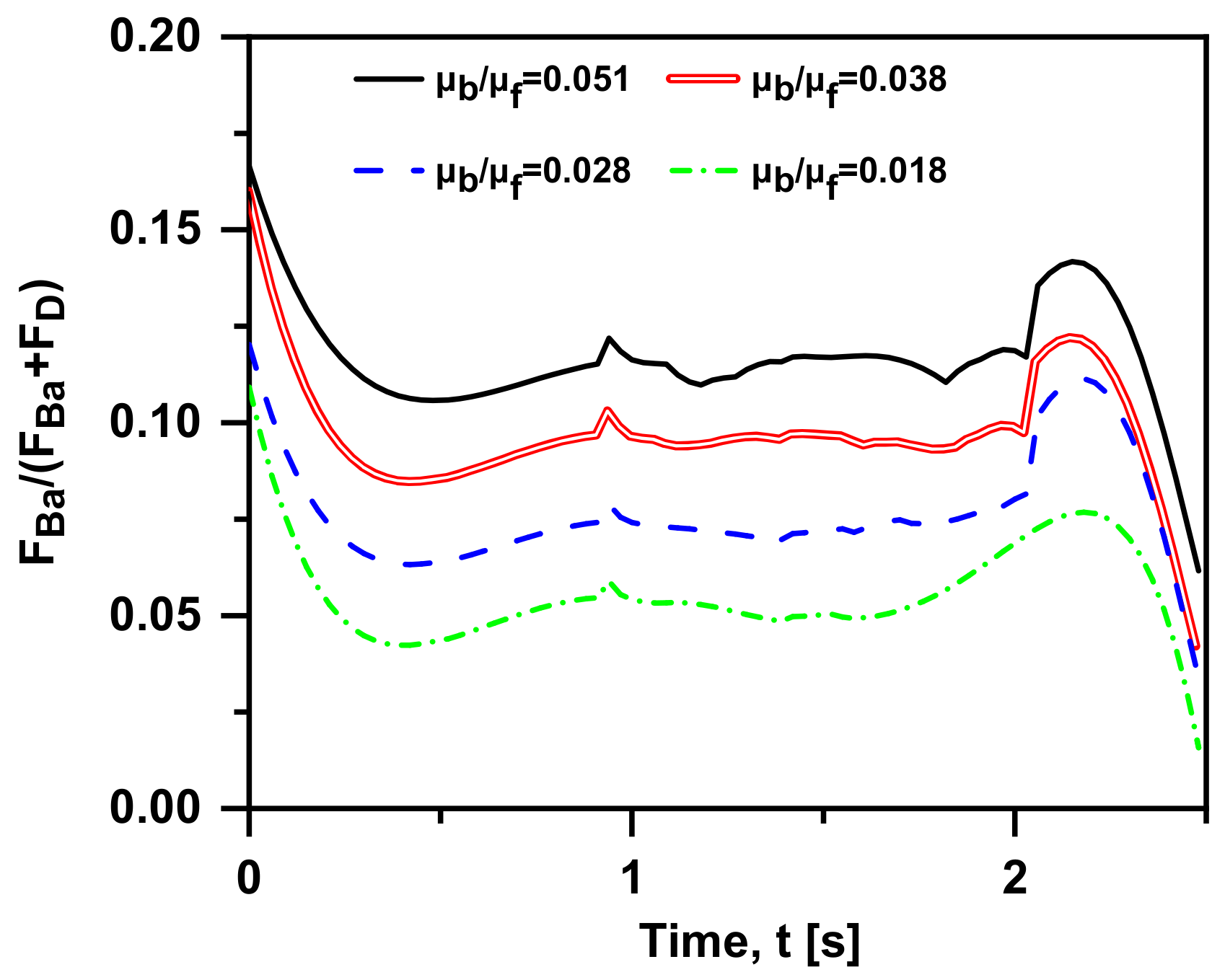
| n | Explanation | ||
|---|---|---|---|
| 0 | The particle moves at constant acceleration relative to the fluid. Basset force increases monotonically with t and can reach a considerable order of magnitude given enough large t. (When b = 0, the particle will move at a uniform speed relative to the fluid and 0) | ||
| 1 | The particle makes an aperiodic variable acceleration motion relative to the fluid. | varies with t according to the law of 3/2 power. | |
| k | varies with t according to the law of 1/2 power increase. | ||
| Material | Density (kg/m3) | Viscosity (Pa·s) |
|---|---|---|
| Air | 1.29 | 1.8 × 10−5 |
| Water | 1000 | 1.0 × 10−3 |
| Mesh | Nodes | Hexahedral Cells | GCI (%) |
|---|---|---|---|
| 1.1 mm grid size (mesh 1) | 10,528,218 | 10,417,488 | 0.52 |
| 1.2 mm grid size (mesh 2) | 8,194,765 | 8,101,296 | 1.71 |
| 1.5 mm grid size (mesh 3) | 4,272,020 | 4,211,392 | 2.81 |
| 2.0 mm grid size (mesh 4) | 1,859,688 | 1,824,977 | 5.06 |
| 3.0 mm grid size (mesh 5) | 570,741 | 554,944 | 10.05 |
Publisher’s Note: MDPI stays neutral with regard to jurisdictional claims in published maps and institutional affiliations. |
© 2022 by the authors. Licensee MDPI, Basel, Switzerland. This article is an open access article distributed under the terms and conditions of the Creative Commons Attribution (CC BY) license (https://creativecommons.org/licenses/by/4.0/).
Share and Cite
Chen, H.; Ding, W.; Wei, H.; Saxén, H.; Yu, Y. A Coupled CFD-DEM Study on the Effect of Basset Force Aimed at the Motion of a Single Bubble. Materials 2022, 15, 5461. https://doi.org/10.3390/ma15155461
Chen H, Ding W, Wei H, Saxén H, Yu Y. A Coupled CFD-DEM Study on the Effect of Basset Force Aimed at the Motion of a Single Bubble. Materials. 2022; 15(15):5461. https://doi.org/10.3390/ma15155461
Chicago/Turabian StyleChen, Huiting, Weitian Ding, Han Wei, Henrik Saxén, and Yaowei Yu. 2022. "A Coupled CFD-DEM Study on the Effect of Basset Force Aimed at the Motion of a Single Bubble" Materials 15, no. 15: 5461. https://doi.org/10.3390/ma15155461






